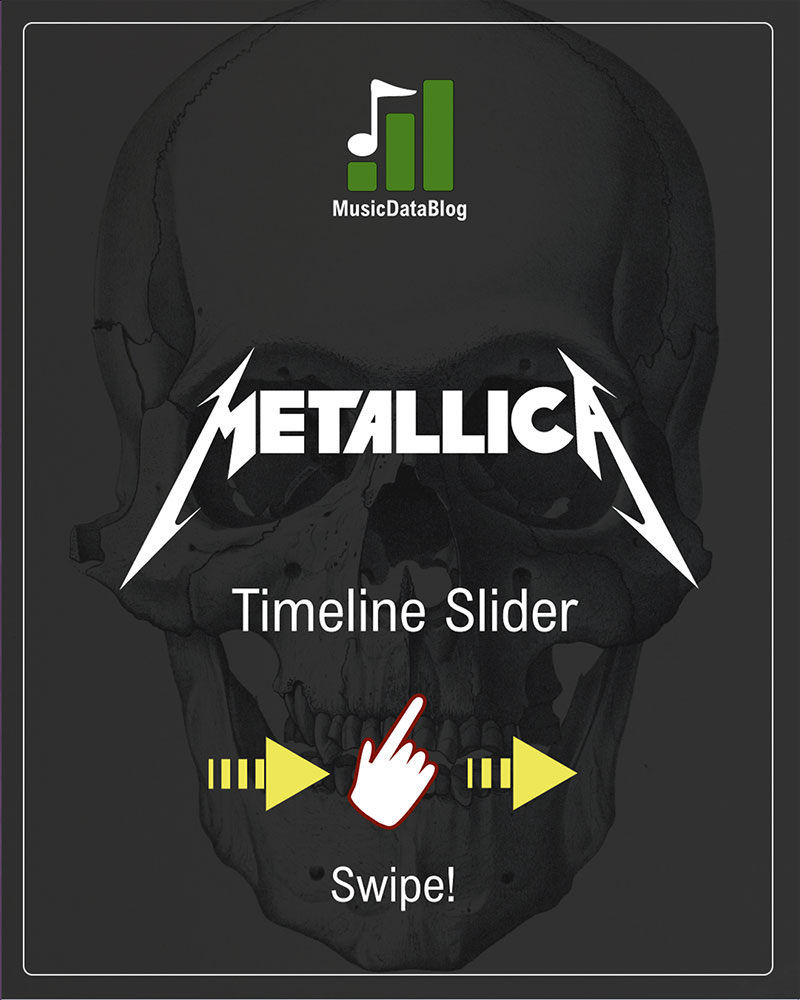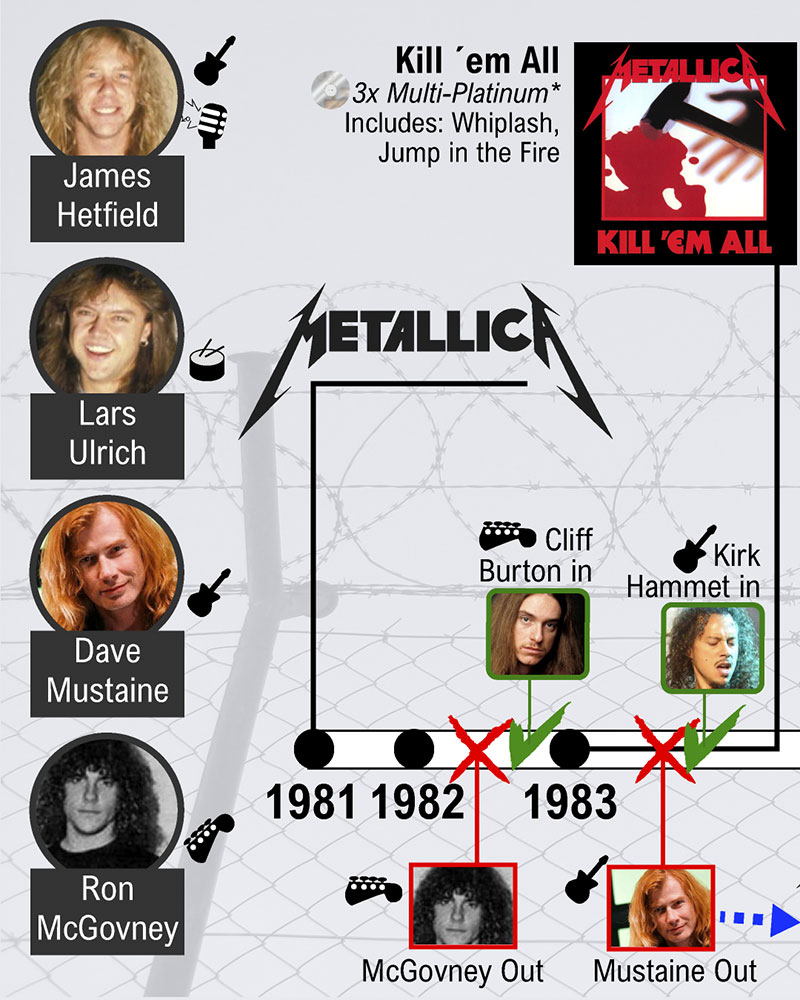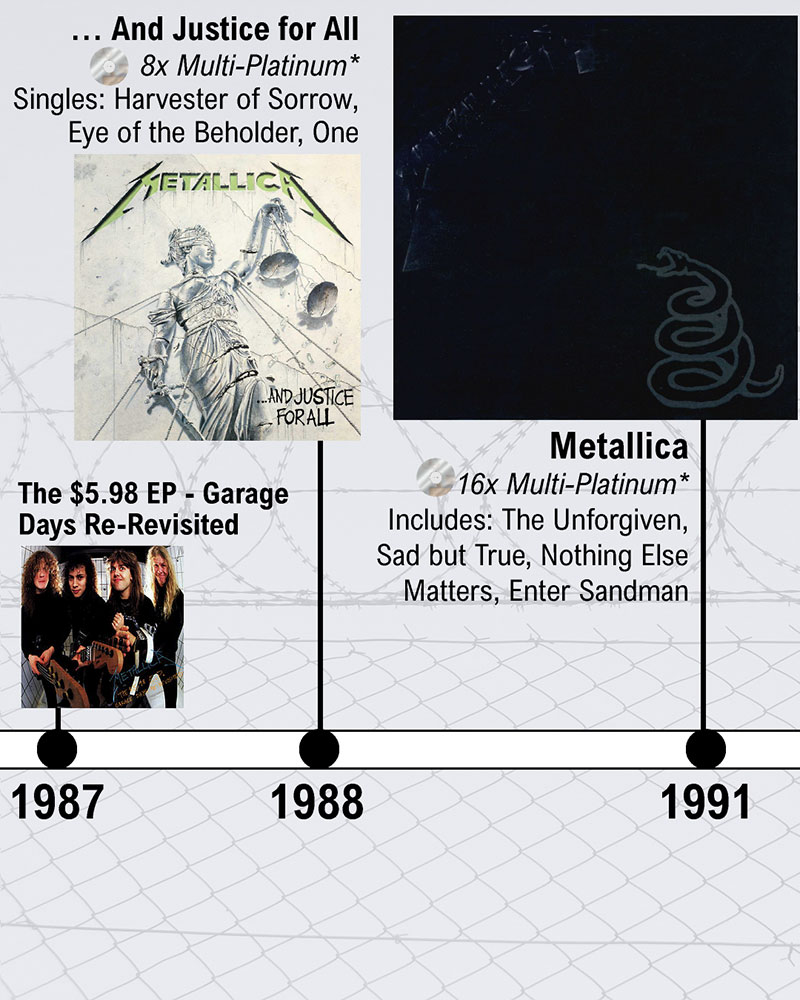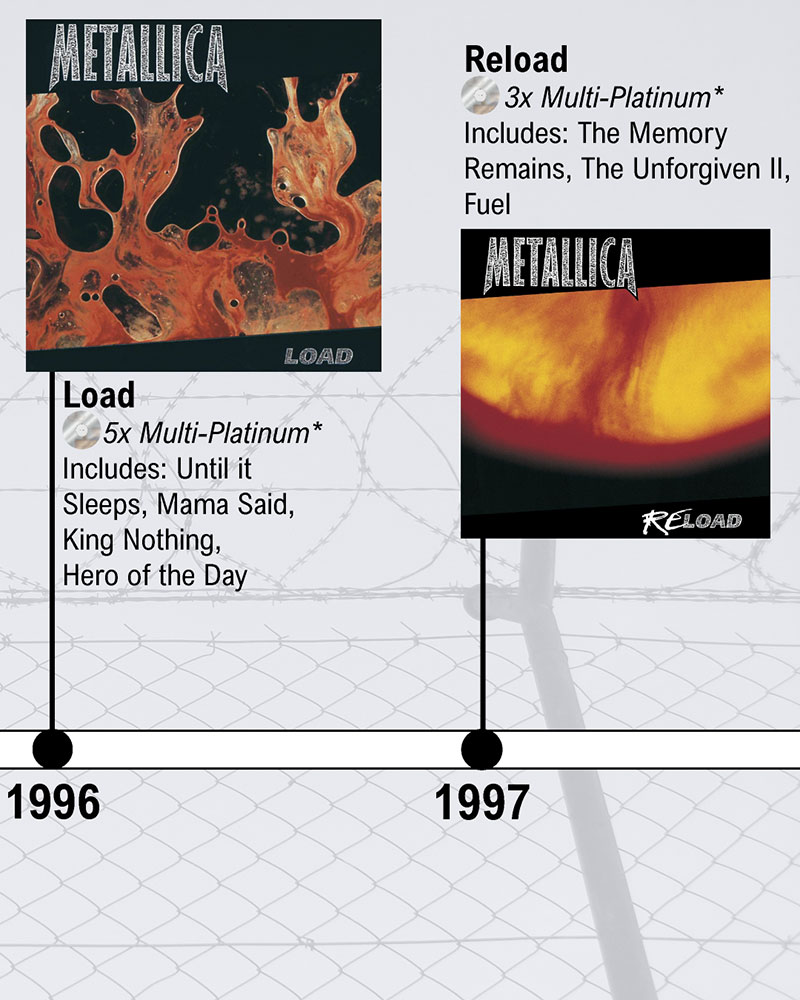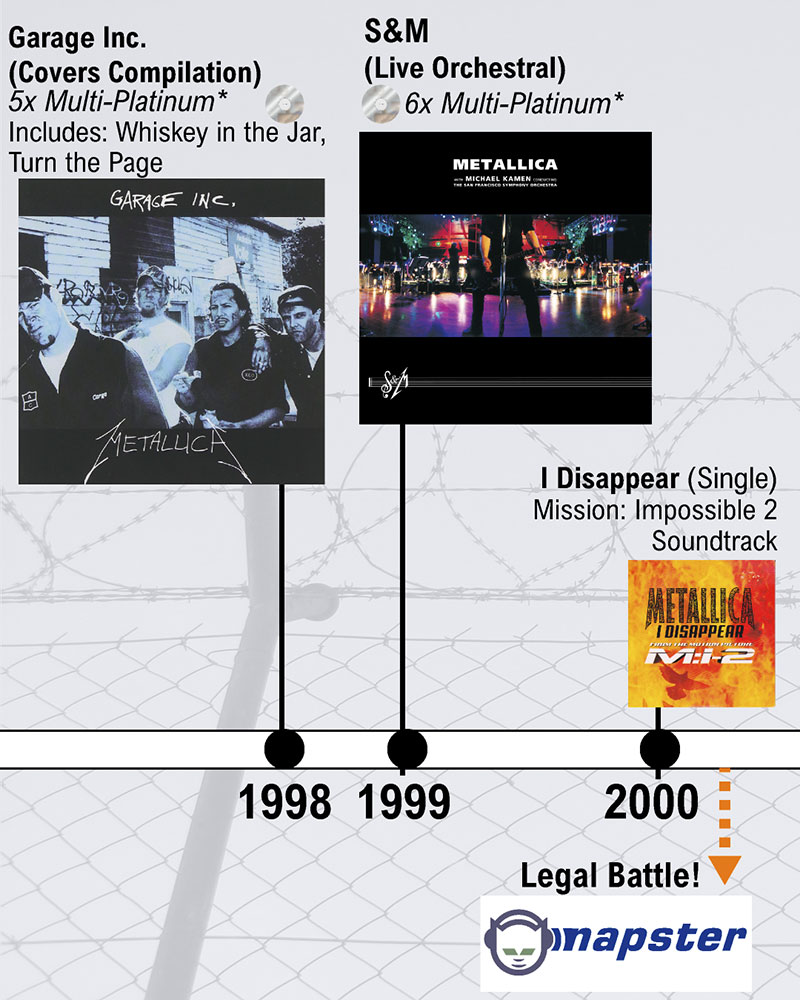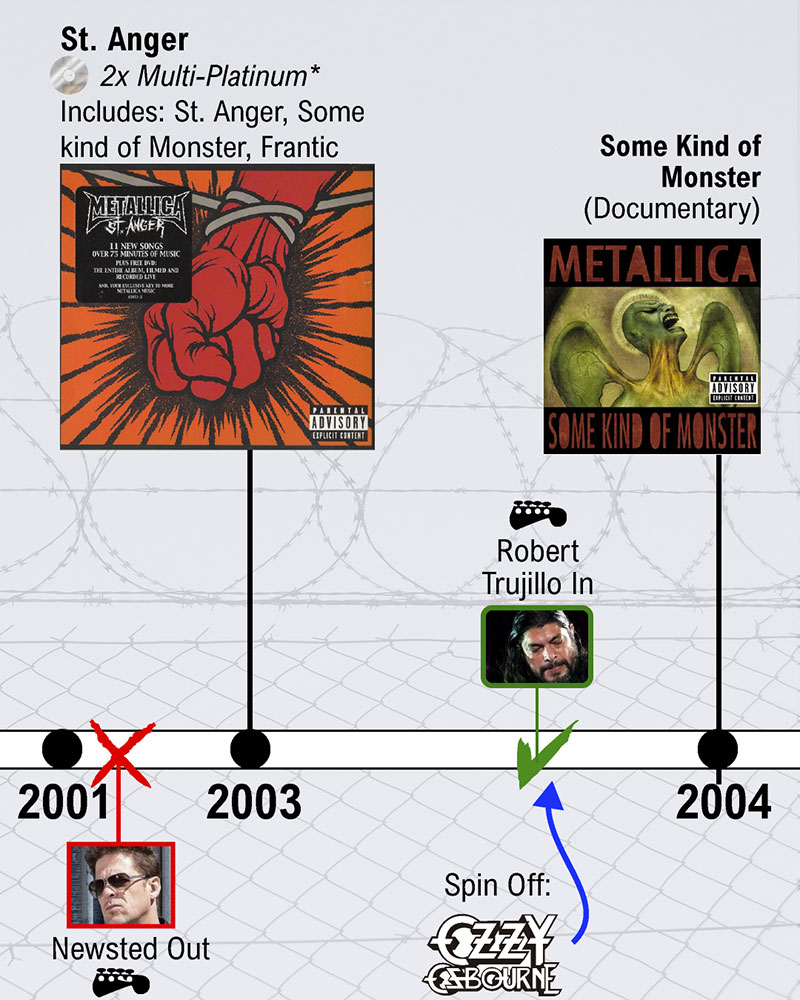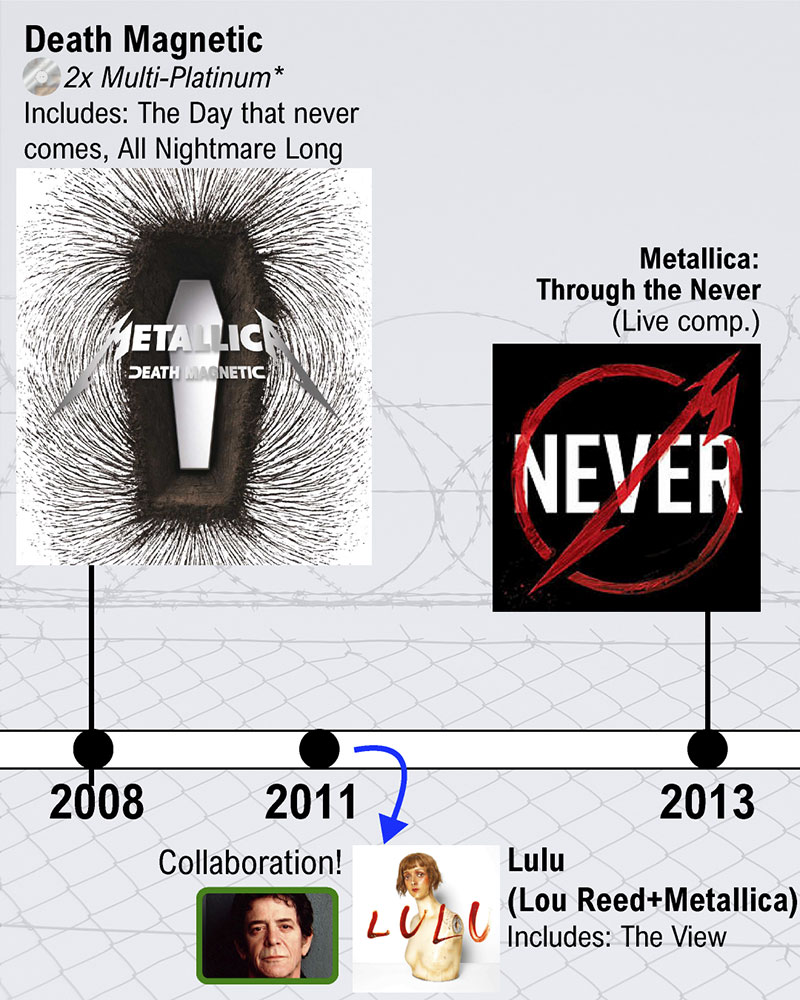Here we have the history of Metallica told in a visual timeline. Check the trajectory of these heavy metal champions, which also includes other iconic artists like Megadeth, Lou Reed and even the band’s beef with Napster.
Throughout their history, Metallica has released eleven studio albums. Their most recent LP, 72 Seasons, was released in 2023.
How Metallica Started with Dave Mustaine
Metallica started in 1981 in Los Angeles, California, USA. After some turns and rounds, James Hetfield (guitar) and Lars Ulrich (drums) settled as the creative core of the band. They later met bassist Cliff Burton, after hearing his impressive bass-playing abilities which we all came to know him for.
The band developed a raw and heavy sound style, with powerful instrumentation. They eventually became a reference thrash metal band.
Metallica ‘s first lineup briefly included Dave Mustaine on guitar, but he did not get along so well with the other members of the band so before the release of their first album, he was kicked out. He was replaced by guitarist Kirk Hammet.
Metallica vs. Megadeth
A spin-off of Metallica history: Dave Mustaine then founded their heavy metal counterpart Megadeth in 1983. Mustaine resented his former bandmates for kicking him out of the band, so Metallica and Megadeth became rivals.
Especially during the 80s decade, both bands started to become more and more popular and eventually became massive acts in the early 90s. In regards to the Metallica vs. Megadeth rivalry, we can say Hetfield and Ulrich’s band outsold Mustaines project. But heavy metal fans love both bands.
Classic Metallica
In 1983 Metallica released their debut album: Kill ’em All. Their impact on the underground metal music scene began to grow from the beginning. The subsequent releases, Ride the Lightning in 1984 and the mythical Master of Puppers in 1986, helped cement their reputation as a metal band.
Cliff Burton’s death in 1986
It was during the tour for Master of Puppers in 1986 that bassist Cliff Burton died in a bus accident. By that time Metallica was a very respected and well-known metal band in the United States.ç
Jason Newsted as the new Metallica bassist
Metallica decided to continue with a new bass player: Jason Newsted joined the band and released an EP of cover versions in 1988. Then, that same year the critically acclaimed … And Justice for All was released. Many critics commented that even though this was a good record, the bass can not be heard properly as a result of a bad sound mix and production.
Metallica’s rise to fame: the early 90s
The big break for Metallica came in 1991 with their self-titled album, also known as the black album. This record has memorable tunes that became classics: Enter Sandman, Nothing Else Matters, and The Unforgiven.
With the Black Album, Metallica established themselves as the biggest-selling band from the “Big Four” of heavy metal bands, outranking Megadeth. Metallica’s self-titled LP was certified 16x Platinum in the United States and was a worldwide success.
Style change: How Metallica cut their hair and refined their sound
After years of not releasing any new material, the band returned with a completely different look: short hair and a clean attitude, grown-ups that took things more seriously. That was when they released two records that usually split their fans and critics: Load in 1996 and Reload in 1997.
1998 was the year for the covers album Garage Inc. The following year, in 1999, the classic orchestral live album S&M was released. Even though this was a really productive time for Metallica but no new original tracks were released.
How Metallica’s crisis got them their worst album
In 2001 Jason Newsted left the band because of rising conflicts between Metallica‘s agenda and his other musical projects. Without a proper bass player, Metallica continued to record their next album in 2003, which is considered to be their worst: St. Anger. The production on this record and especially the snare drum sound were the focus of a lot of criticism.
With that album already released, Metallica hired a new bass player: the versatile Robert Trujillo. This cemented the current Metallica lineup, which consists of James Hetfield (vocals and guitar), Lars Ulrich (drums), Kirk Hammet (guitar) y Robert Trujillo (bass).
Metallica then released their albums Death Magnetic in 2008 and a collaboration album with Lou Reed titled Lulu in 2011. Especially the later gathered mixed reviews from music critics and the press, as well as the fans.
Metallica’s resurgence
Hardwired… to selfdestruct was released in 2013, and it did better in terms of album sales and popularity among fans.
In 2022 Netflix’s popular series, Stranger Things, featured the classic Metallica song Master of Puppets. The track reentered the music charts and reminded the public that the band was still one of the most important heavy metal bands that ever existed.
In 2023 Metallica released their long-awaited new album, 72 Seasons. The record received positive reviews from the public and critics.
Metallica’s Discography
Metallica has released eleven studio albums and some live albums as well, but for the latter, we will just mention S&M, their live symphonic effort, which became a classic. Here are all Metallica albums listed:
- Kill em All (1983)
- Ride the Lightning (1984)
- Master of Puppets (1986)
- … And Justice for all (1988)
- Metallica (1991)
- Load (1996)
- Reload (1997)
- Garage Inc. (1998)
- S&M (1999)
- St. Anger (2003)
- Death Magnetic (2008)
- Lulu (With Lou Reed, 2011)
- Hardwired… To Self-destruct (2016)
- 72 Seasons (2023)

